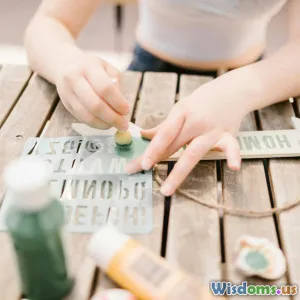
Family Friendly DIY Science Projects
8 min read Explore engaging, educational family-friendly DIY science projects that inspire creativity and learning at home. (0 Reviews)
Family Friendly DIY Science Projects: Ignite Curiosity at Home
Science is everywhere, and the best way to understand it is by getting hands-on. Engaging your family in DIY science projects isn’t just a way to pass time; it’s a valuable opportunity to nurture curiosity, critical thinking, and creativity in children and adults alike. Whether you’re a seasoned educator or just a parent wanting to bring more learning and laughter into home life, these projects offer exciting experiments that the whole family can enjoy and learn from.
Why Choose Family Friendly DIY Science Projects?
In today’s fast-paced digital world, children often experience “screen fatigue,” and educational toys can sometimes disconnect kids from the process of discovery. DIY science projects counteract these challenges by combining tactile learning with real-world applications, fostering deeper understanding and retention.
Moreover, science projects at home don't require professional equipment or costly kits. Simple, everyday materials can lead to spectacular results, creating memorable moments and sparking lifelong interest.
According to a 2019 study by the National Science Teaching Association, engaging children in informal science activities attuned to family settings significantly boosts their confidence and interest in STEM fields.
Getting Started: Tips for Hosting Your At-Home Science Lab
Before diving in, set some ground rules and ensure an environment conducive to safe experimentation:
- Choose experiments based on age suitability. Younger kids require more supervision.
- Prepare all materials beforehand.
- Emphasize safety, including protective eyewear if necessary.
- Encourage asking questions. Curiosity drives science!
Having a dedicated space, even a small table, makes the process feel special and organized.
Top DIY Science Projects for Families
1. Homemade Volcano: Chemistry Meets Geology
One of the most classic and thrilling experiments is creating a baking soda and vinegar volcano. This project elucidates chemical reactions in an accessible way.
Materials:
- Baking soda
- Vinegar
- Dish soap
- Red food coloring
- A container to form the volcano
How It Works: Mixing baking soda (a base) and vinegar (an acid) triggers a reaction that produces carbon dioxide gas, creating an eruptive fizz similar to volcanic lava.
This simple experiment demonstrates acids, bases, and gas formation. Parents can deepen the lesson by discussing natural volcanoes, types, and their impact on the environment.
2. DIY Solar Oven: Harnessing Renewable Energy
Teach kids about solar energy and heat transfer by building a cabinet solar oven using cardboard boxes, aluminum foil, and plastic wrap.
Materials:
- Two cardboard boxes, one smaller than the other
- Aluminum foil
- Plastic wrap
- Black construction paper
- Tape and scissors
How It Works: The oven captures sunlight, concentrates it, and traps heat inside, allowing you to cook simple items like s'mores or melt chocolate.
It's an engaging way to explain renewable energy and the greenhouse effect in an interactive manner.
3. Growing Crystals: Exploring Chemical Structures
Growing crystals lets children observe mineral formation in real time. Using borax or salt creates sparkly shapes over days.
Materials:
- Borax powder or table salt
- Hot water
- A jar
- Pipe cleaners fashioned into shapes
How It Works: The hot water dissolves the borax or salt, and as the solution cools, crystals form on the pipe cleaners by deposition.
Watching this slow transformation encourages patience and observation, linking chemistry with art.
4. Rainbow Density Tower: Diving Into Liquid Science
Build a density tower to study liquid properties and layering using household liquids of different densities.
Materials:
- Honey
- Dish soap
- Water (colored with food coloring)
- Vegetable oil
- Rubbing alcohol (colored)
- Tall transparent container
How It Works: Each liquid has a distinct density, allowing them to layer without mixing, forming a rainbow effect. Dropping objects into the tower shows where they sink or float, connecting density with buoyancy.
This project imparts critical insight into fluid properties and encourages hypothesis testing.
5. Static Electricity Butterflies: Understanding Electric Charges
Demonstrate static electricity through a simple butterfly craft that moves using charged balloon static.
Materials:
- Tissue paper
- String or thread
- Balloons
How It Works: Rubbing balloons on hair or fabric builds up static electricity. Bringing the balloon close to the paper butterfly causes the wings to flutter due to an electric charge interaction.
This invisible force can open discussions on electricity in nature and physics fundamentals.
The Science of Togetherness: Benefits Beyond the Experiment
DIY science projects aren’t just about acquiring knowledge. They are opportunities for family members to build communication, teamwork, and problem-solving skills. Educational psychologist Dr. Ellen Sandler notes, "Working together on science experiments supports relationships and promotes collaborative learning—two critical components for healthy child development."
Moreover, creating and observing results firsthand elevates a child’s confidence when grappling with abstract concepts. This hands-on approach makes science tangible and enjoyable instead of intimidating.
Incorporating Technology and Expanding Horizons
For families ready to take the plunge into blended learning, supplement these projects with interactive apps such as "TinkerCrate" or "Science Journal." These tools allow data report, experiment logging, and extended lessons for further exploration.
Community science fairs and virtual meetups also offer platforms where kids can share their DIY projects and learn from peers worldwide, making science a living, social subject.
Conclusion: Spark Curiosity and Make Memories
Family friendly DIY science projects bring wonder and education into the home by making science accessible and exhilarating. With nothing more than household items, you can engage all ages with experiments that inspire wonder, teach fundamental principles, and create lasting memories. Remember, the true magic lies not just in the project’s outcome but in the journey of exploring, hypothesizing, and discovering alongside your loved ones.
So gather your supplies, open your minds, and watch the seeds of curiosity sprout through hands-on science!
References:
- National Science Teaching Association, Informal Science Learning and its Impacts, 2019
- Sandler, E. (2021). "The Role of Collaborative Learning in Child Development." Journal of Educational Psychology
Happy experimenting!
Rate the Post
User Reviews
Popular Posts





















